Abstract
OBJECTIVE--To determine the relative efficacy in general practice of dietary advice given by a dietitian, a practice nurse, or a diet leaflet alone in reducing total and low density lipoprotein cholesterol concentration. DESIGN--Randomised six month parallel trial. SETTING--A general practice in Oxfordshire. SUBJECTS--2004 subjects aged 35-64 years were screened for hypercholesterolaemia; 163 men and 146 women with a repeat total cholesterol concentration of 6.0-8.5 mmol/l entered the trial. INTERVENTIONS--Individual advice provided by a dietitian using a diet history, a practice nurse using a structured food frequency questionnaire, or a detailed diet leaflet sent by post. All three groups were advised to limit the energy provided by fat to 30% or less and to increase carbohydrate and dietary fibre. MAIN OUTCOME MEASURES--Concentrations of total cholesterol and low density and high density lipoprotein cholesterol after six months; antioxidant concentration and body mass index. RESULTS--No significant differences were found at the end of the trial between groups in mean concentrations of lipids, lipoproteins, and antioxidants or body mass index. After data were pooled from the three groups, the mean total cholesterol concentration fell by 1.9% (0.13 mmol/l, 95% confidence interval 0.06 to 0.22, P < 0.001) to 7.00 mmol/l, and low density lipoprotein cholesterol also fell. The total carotenoid concentration increased by 53 nmol/l (95% confidence interval 3.0 to 103, P = 0.039). CONCLUSIONS--Dietary advice is equally effective when given by a dietitian, a practice nurse, or a diet leaflet alone but results in only a small reduction in total and low density lipoprotein cholesterol. To obtain a better response more intensive intervention than is normally available in primary care is probably necessary.
Full text
PDF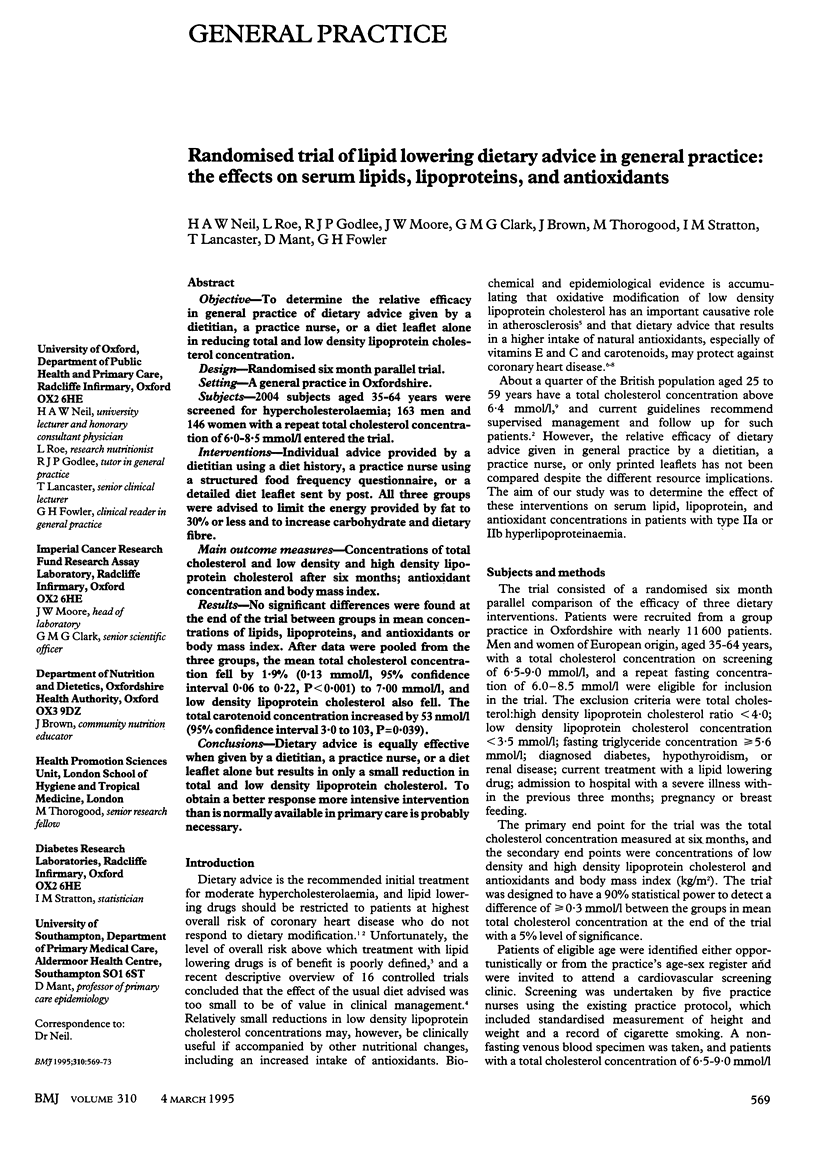
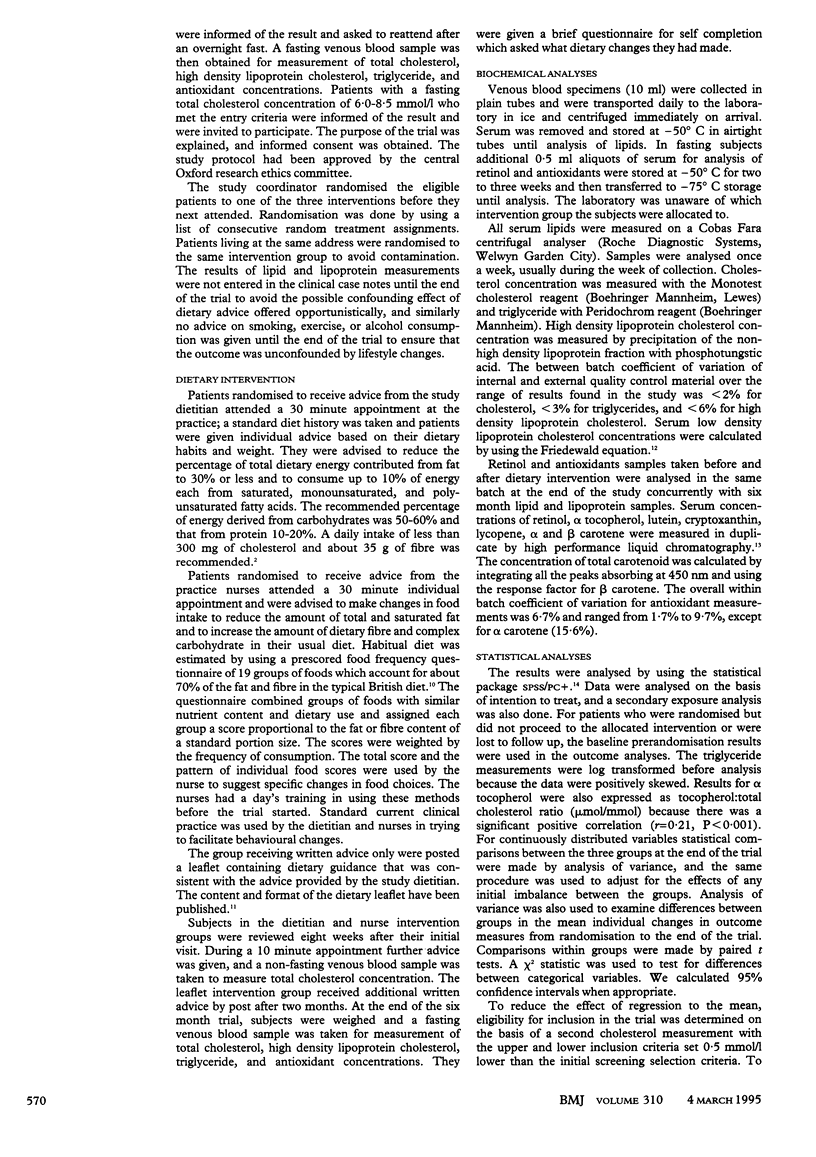
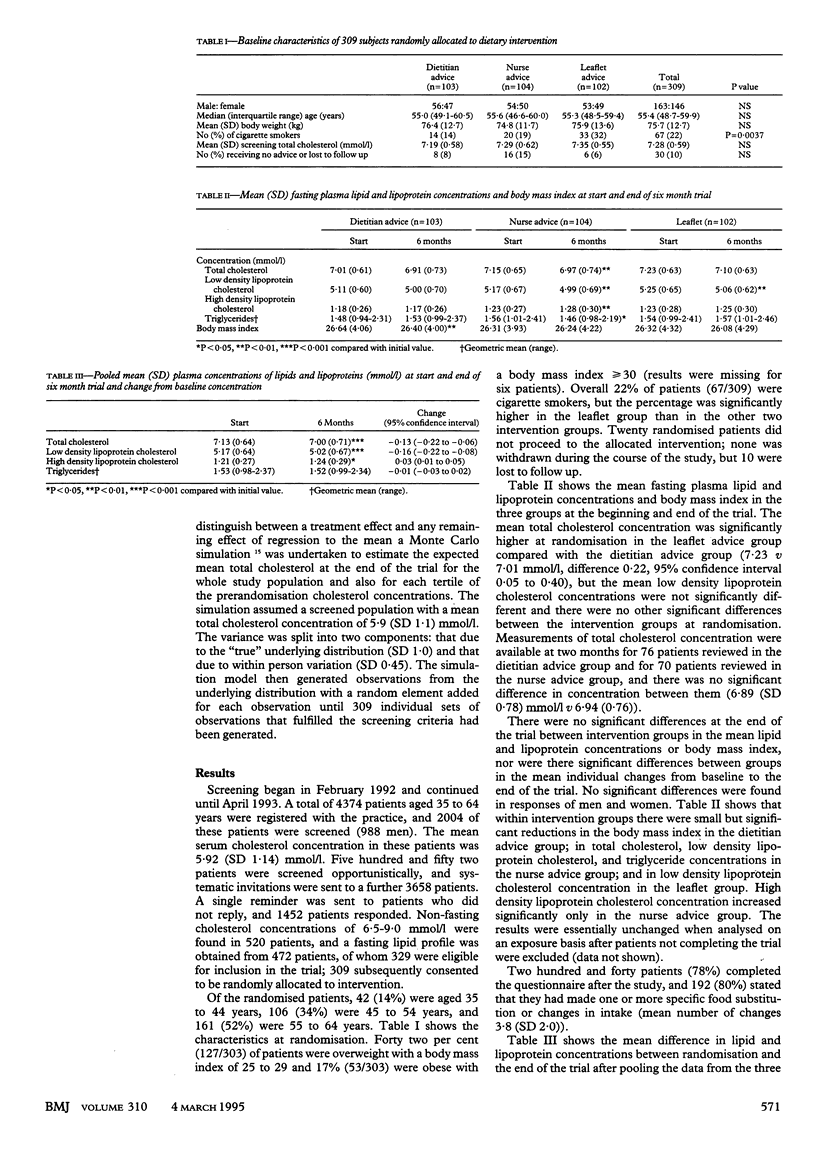
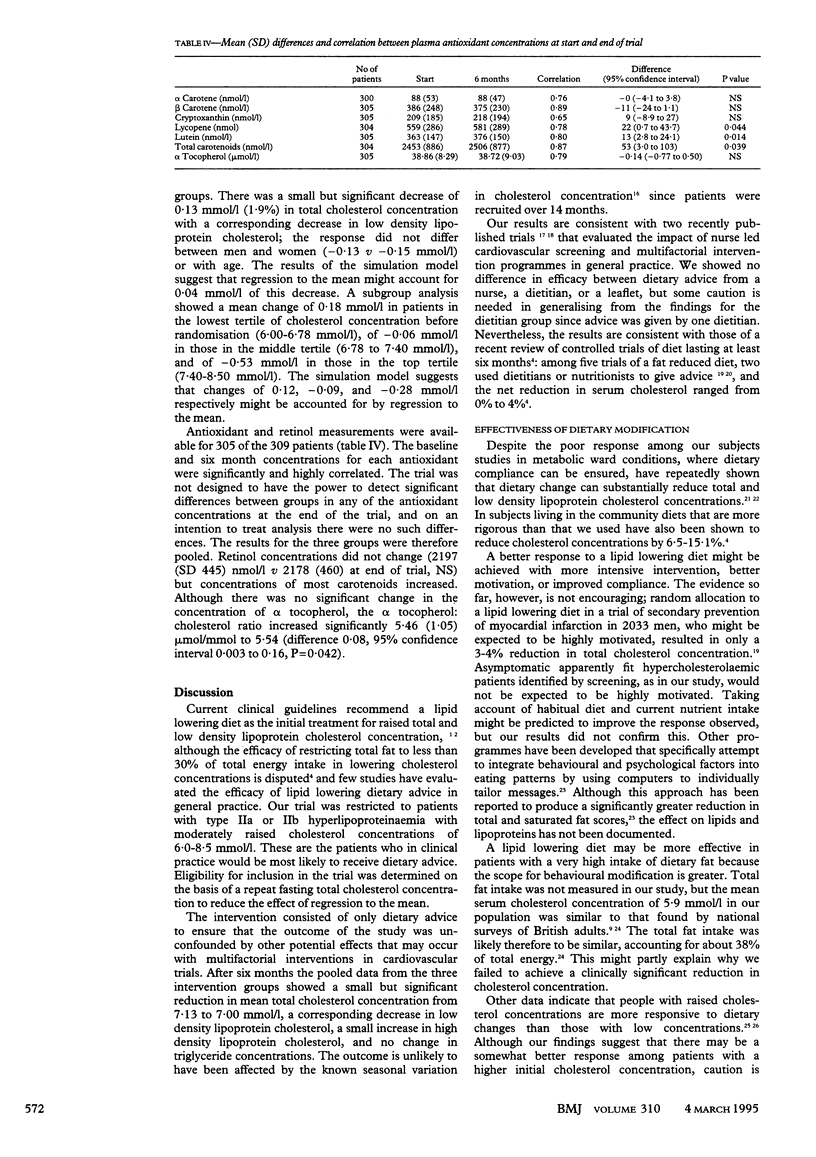
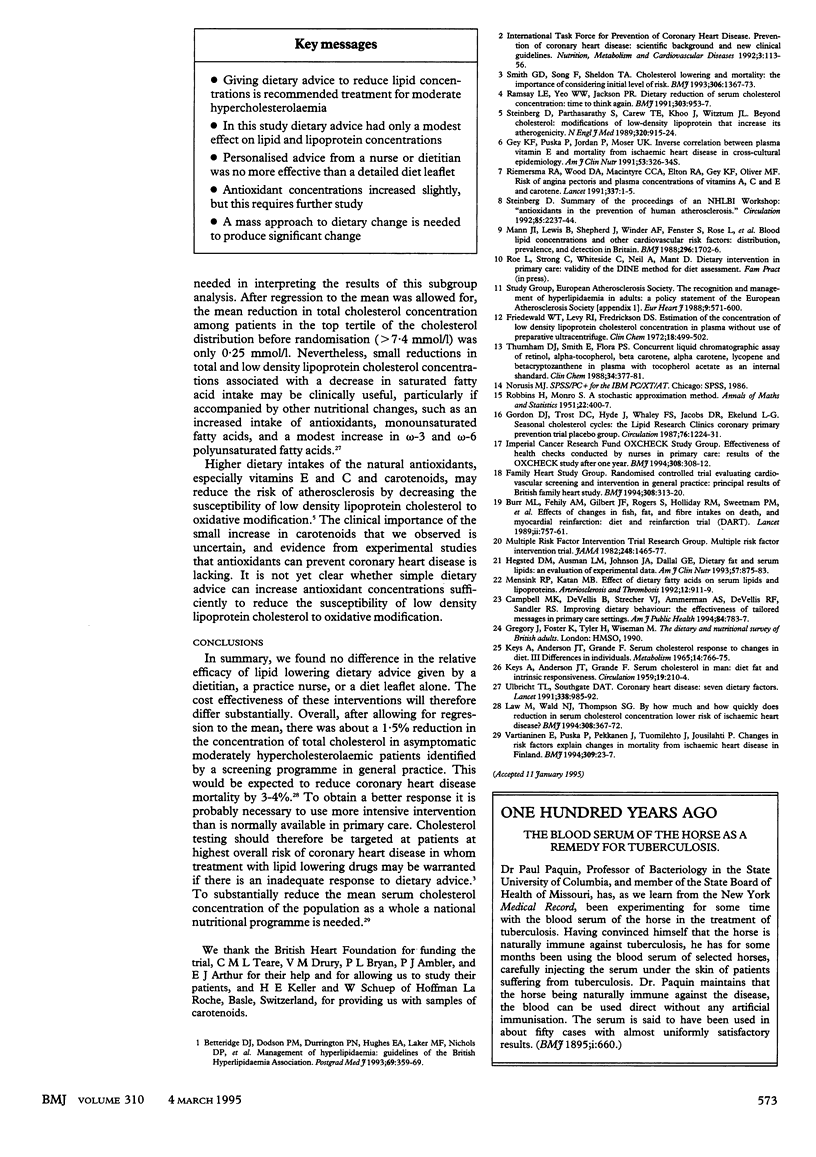
Selected References
These references are in PubMed. This may not be the complete list of references from this article.
- Betteridge D. J., Dodson P. M., Durrington P. N., Hughes E. A., Laker M. F., Nicholls D. P., Rees J. A., Seymour C. A., Thompson G. R., Winder A. F. Management of hyperlipidaemia: guidelines of the British Hyperlipidaemia Association. Postgrad Med J. 1993 May;69(811):359–369. doi: 10.1136/pgmj.69.811.359. [DOI] [PMC free article] [PubMed] [Google Scholar]
- Burr M. L., Fehily A. M., Gilbert J. F., Rogers S., Holliday R. M., Sweetnam P. M., Elwood P. C., Deadman N. M. Effects of changes in fat, fish, and fibre intakes on death and myocardial reinfarction: diet and reinfarction trial (DART). Lancet. 1989 Sep 30;2(8666):757–761. doi: 10.1016/s0140-6736(89)90828-3. [DOI] [PubMed] [Google Scholar]
- Campbell M. K., DeVellis B. M., Strecher V. J., Ammerman A. S., DeVellis R. F., Sandler R. S. Improving dietary behavior: the effectiveness of tailored messages in primary care settings. Am J Public Health. 1994 May;84(5):783–787. doi: 10.2105/ajph.84.5.783. [DOI] [PMC free article] [PubMed] [Google Scholar]
- Friedewald W. T., Levy R. I., Fredrickson D. S. Estimation of the concentration of low-density lipoprotein cholesterol in plasma, without use of the preparative ultracentrifuge. Clin Chem. 1972 Jun;18(6):499–502. [PubMed] [Google Scholar]
- Gordon D. J., Trost D. C., Hyde J., Whaley F. S., Hannan P. J., Jacobs D. R., Jr, Ekelund L. G. Seasonal cholesterol cycles: the Lipid Research Clinics Coronary Primary Prevention Trial placebo group. Circulation. 1987 Dec;76(6):1224–1231. doi: 10.1161/01.cir.76.6.1224. [DOI] [PubMed] [Google Scholar]
- Hegsted D. M., Ausman L. M., Johnson J. A., Dallal G. E. Dietary fat and serum lipids: an evaluation of the experimental data. Am J Clin Nutr. 1993 Jun;57(6):875–883. doi: 10.1093/ajcn/57.6.875. [DOI] [PubMed] [Google Scholar]
- Law M. R., Wald N. J., Thompson S. G. By how much and how quickly does reduction in serum cholesterol concentration lower risk of ischaemic heart disease? BMJ. 1994 Feb 5;308(6925):367–372. doi: 10.1136/bmj.308.6925.367. [DOI] [PMC free article] [PubMed] [Google Scholar]
- Mann J. I., Lewis B., Shepherd J., Winder A. F., Fenster S., Rose L., Morgan B. Blood lipid concentrations and other cardiovascular risk factors: distribution, prevalence, and detection in Britain. Br Med J (Clin Res Ed) 1988 Jun 18;296(6638):1702–1706. doi: 10.1136/bmj.296.6638.1702. [DOI] [PMC free article] [PubMed] [Google Scholar]
- Mensink R. P., Katan M. B. Effect of dietary fatty acids on serum lipids and lipoproteins. A meta-analysis of 27 trials. Arterioscler Thromb. 1992 Aug;12(8):911–919. doi: 10.1161/01.atv.12.8.911. [DOI] [PubMed] [Google Scholar]
- Ramsay L. E., Yeo W. W., Jackson P. R. Dietary reduction of serum cholesterol concentration: time to think again. BMJ. 1991 Oct 19;303(6808):953–957. doi: 10.1136/bmj.303.6808.953. [DOI] [PMC free article] [PubMed] [Google Scholar]
- Riemersma R. A., Wood D. A., Macintyre C. C., Elton R. A., Gey K. F., Oliver M. F. Risk of angina pectoris and plasma concentrations of vitamins A, C, and E and carotene. Lancet. 1991 Jan 5;337(8732):1–5. doi: 10.1016/0140-6736(91)93327-6. [DOI] [PubMed] [Google Scholar]
- Smith G. D., Song F., Sheldon T. A. Cholesterol lowering and mortality: the importance of considering initial level of risk. BMJ. 1993 May 22;306(6889):1367–1373. doi: 10.1136/bmj.306.6889.1367. [DOI] [PMC free article] [PubMed] [Google Scholar]
- Steinberg D., Parthasarathy S., Carew T. E., Khoo J. C., Witztum J. L. Beyond cholesterol. Modifications of low-density lipoprotein that increase its atherogenicity. N Engl J Med. 1989 Apr 6;320(14):915–924. doi: 10.1056/NEJM198904063201407. [DOI] [PubMed] [Google Scholar]
- Thurnham D. I., Smith E., Flora P. S. Concurrent liquid-chromatographic assay of retinol, alpha-tocopherol, beta-carotene, alpha-carotene, lycopene, and beta-cryptoxanthin in plasma, with tocopherol acetate as internal standard. Clin Chem. 1988 Feb;34(2):377–381. [PubMed] [Google Scholar]
- Ulbricht T. L., Southgate D. A. Coronary heart disease: seven dietary factors. Lancet. 1991 Oct 19;338(8773):985–992. doi: 10.1016/0140-6736(91)91846-m. [DOI] [PubMed] [Google Scholar]
- Vartiainen E., Puska P., Pekkanen J., Tuomilehto J., Jousilahti P. Changes in risk factors explain changes in mortality from ischaemic heart disease in Finland. BMJ. 1994 Jul 2;309(6946):23–27. doi: 10.1136/bmj.309.6946.23. [DOI] [PMC free article] [PubMed] [Google Scholar]


